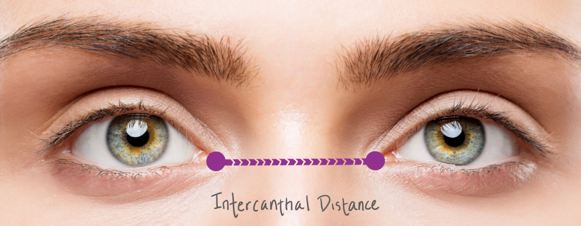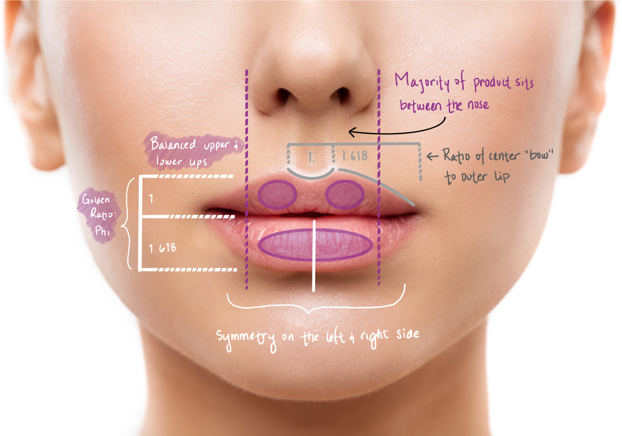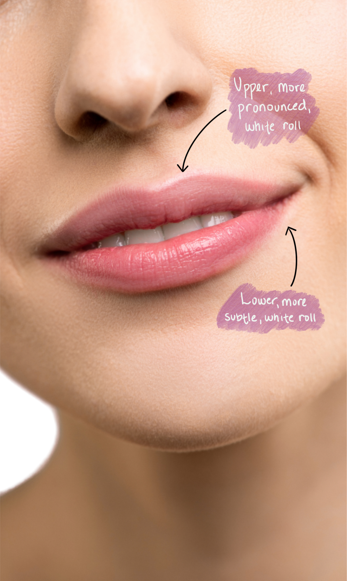
Even in stillness, lips convey a message. To enhance the natural beauty of lips, I often employ a combination of techniques, including lasers, radiofrequency or ultrasound devices, antioxidant-rich products, and neuromodulators like Botox, Dysport, or Xeomin, along with hyaluronic acid fillers. Lip products designed to impart a plumping effect visibly enhance volume and fullness. Additionally, consistent use of sun protection is crucial to safeguard against collagen breakdown and protect this delicate facial area. Before addressing the lips, I conduct a comprehensive evaluation of the entire face, considering factors such as teeth, the surrounding mouth area, and especially the chin.
Factors to Consider for Lovely Lips: Your genetics, age group, personality, lifestyle, race, culture, and gender all play a role. It's all about paying attention to details – the subtle nuances that can make a significant impact.
Eyes: To address fine lines and wrinkles around the eyes, consider using products like a retinoid eye cream, such as CE HPR Eye. The intercanthal distance, a purple line extending from one inner eyelid to the other, remains constant from 9 months to 90 years and is unique to each individual. This distance establishes the ideal balance and proportions for your entire face, including the lips, and is referred to as your "phi" or golden ratio.
The application of the golden ratio in our approach to each patient varies based on cultural and ethnic considerations, as well as your distinctive facial features. However, it serves as the foundation for our analysis and treatment planning, aiming to naturally enhance and optimize your beauty.

BEGIN WITH THE LIP SURROUNDINGS:
My initial focus is on examining the teeth. Frequently, when lips appear flat or asymmetrical, it's often attributed to inadequate support from the underlying teeth. Common issues include a pronounced overbite, misaligned teeth, or teeth angled inward, and failure to provide proper support to the upper lip. While we can attempt to correct the lips, the outcomes may not be as effective or enduring if we neglect to address the root cause that detracts from the targeted area.

The central "bow" to the outer lip should adhere to the correct ratio. Nefertiti and Angelina Jolie serve as exemplary instances of achieving the golden ratio balance and proportion, known as "phi."
Gummy Smile: I systematically observe the lips both at rest and in motion. While some individuals possess beautifully full lips at rest, they may appear small, flat, or roll under when they smile, revealing their gums. This issue can be effectively addressed with a neuromodulator like Botox, yielding fantastic results. Precise injection techniques are essential in this area due to the various types of gummy smiles and the potential impact on speech, affecting the pronunciation of certain sounds, such as the letters 'p' or 'o'.
 The outcomes are outstanding when executed proficiently, but unfortunately, they persist for an extended period when not administered correctly. Fundamental principles for lip enhancement include ensuring the left and right sides are symmetrical. In individuals with fair skin, the ideal ratio between the upper and lower lip is 1:1.618. The central "bow" to the outer lip should also adhere to a ratio of 1.1.618. It is advisable to focus the majority of the product within the area as wide as the sides of the nose (refer to the image below).
The outcomes are outstanding when executed proficiently, but unfortunately, they persist for an extended period when not administered correctly. Fundamental principles for lip enhancement include ensuring the left and right sides are symmetrical. In individuals with fair skin, the ideal ratio between the upper and lower lip is 1:1.618. The central "bow" to the outer lip should also adhere to a ratio of 1.1.618. It is advisable to focus the majority of the product within the area as wide as the sides of the nose (refer to the image below).
Consider the image on the left, where the white roll functions as the frame of a painting. The upper white roll is more pronounced, while the lower white roll is more subtle.
You may also like to read: How To Master Skincare
Vermillion: This refers to the red and central part of the lips. Various products serve distinct purposes, and at times, layering products enhances the desired effect. The most commonly used filler for lips is hyaluronic acid, with numerous types and brands available, significantly influencing the final appearance and longevity of results. Some fillers are denser, providing more volume or augmentation, while others are softer and more flexible, contributing to a natural enhancement.
The most common product used for lip filler is hyaluronic acid, but there are many different types and brands, and it can make a significant difference in how the result looks and how long the results last.
AESTHETIC PROCEDURE
Step 1:
The doctor may administer a topical anesthetic to alleviate discomfort.
Step 2:
Utilizing either a needle or a cannula (blunt needle), the doctor injects the appropriate product into the lips for augmentation (increasing size) or enhancement (improving beauty and balance). For individuals with relatively smaller lips, patience is key, as achieving the final result may require several sessions with small amounts of a more robust filler. This approach helps prevent excessive projection and the undesirable "duck lip" appearance.
There are various methods for delivering the filler. The doctor may use a needle directly into the targeted area or opt for a blunt needle, known as a cannula. Both methods are excellent options, with the cannula gaining popularity due to its reduced risk of bruising.
Step 3:
Once the desired volume is attained, the doctor may employ a softer filler to further enhance and balance the lips and surrounding area. It takes time for the product to settle, and there may be swelling for a few hours to a few days post-treatment. Bruising, if present, can be addressed with laser treatment to expedite healing if necessary. The majority of the lip product should be concentrated between the nasal ala on one side of the nose to the other, as depicted in the photo above.
Recommended: The Best Rosacea Treatment Clinic in Pakistan
Concluding Outcomes:
Ideally, the lower lip should possess a slight prominence compared to the upper lip, unless dealing with individuals of African American or Asian descent, where the natural proportion dictates both lips to be of similar size. Additionally, it is recommended that the majority of the filler be concentrated within the boundaries extending vertically from one inner eyelid to the other, known as the intercanthal distance, as illustrated in the photo above.

Oral Commissure (Corners of the Mouth): As we age, the corners of the mouth may sag and droop, creating the illusion of a frown even when emotions don't reflect sadness or anger.
A resilient filler can effectively lift this area, instantly rejuvenating the appearance of the lips. Additionally, injecting a small amount of Botox into the muscles along the jawline that contribute to pulling the corners downward can have a remarkable impact, assisting in lifting the corners.
Chin: With aging, women often experience chin recession and diminishment. This can cause the lower lip to retract, appearing smaller, and can make it challenging to maintain lip closure, leading to increased use of surrounding mouth muscles. Consequently, this can result in the development of undesirable upper lip lines. Filling the lower lip without addressing the chin area may result in an unnatural and disproportionate look.
Introducing a filler directly into the center of the chin can restore balance to this area and alter the appearance of the lips even before any product is injected into them. Careful administration is crucial to achieving the desired effect—injecting too low can elongate the face, while injecting too high may create a noticeable bump. There exists a precise, aesthetically pleasing spot for injection that produces beautiful and natural results with lasting effects.

Upper Lip Line Creases: These creases typically result from prolonged sun exposure, repetitive facial movements, and volume loss over time. A suitable approach involves the use of a softer and more flexible hyaluronic acid filler. This not only provides support to the delicate skin around the lips but also stimulates collagen production. Complementary treatments, such as laser therapy, radiofrequency, and in-office procedures, combined with topicals containing retinol and growth factors, may also be necessary to restore and enhance the skin around the lips.
For the best guidance, it is recommended to consult with a board-certified aesthetic physician, such as a dermatologist or plastic surgeon. This ensures a proper assessment and selection of the right products tailored to your needs. Achieving optimal results often requires 2-3 sessions to avoid an overly projected "duck lip" appearance.
Bottom Line:
The objective is to attain balance and harmony between the lips and the overall facial features. A thorough aesthetic evaluation, coupled with the use of appropriate fillers for targeted areas, is crucial for restoring, redefining, and rejuvenating this sensitive and significant facial region. The art of lip injections involves a scientific approach, and for enduring beauty, it is advisable to seek the expertise of a doctor trained in aesthetics, such as a dermatologist or plastic surgeon.


